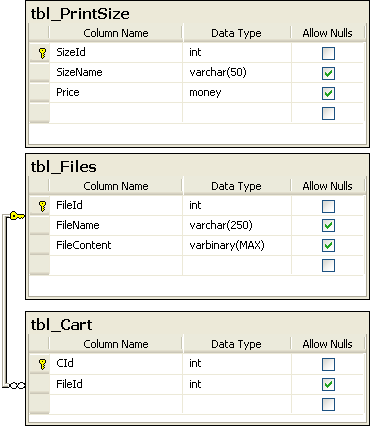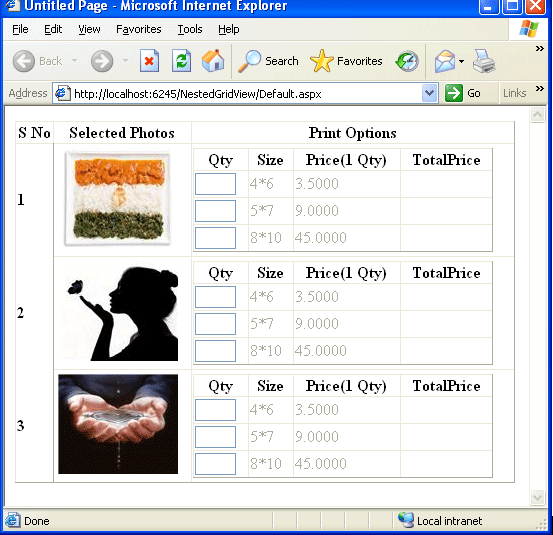Tables:
Create Database with the name as "NestedGridView" and create following tables in that database.

Stored Procedures:
Create Procedure sp_GetFileDetails
(
@FileId int
)
AS
Begin
select * from tbl_Files where FileId = @FileId
End
Create procedure sp_GetFilesFromCart
As
begin
select * from tbl_Cart c inner join tbl_Files f on
f.FileId = c.FileId
end
As
begin
select * from tbl_Cart c inner join tbl_Files f on
f.FileId = c.FileId
end
Create procedure sp_GetPrintSize
As
Begin
select * from tbl_PrintSize
End
Web.config:
<connectionStrings>
<add name="constr" connectionString="User Id = sa; Password = 123; Database = NestedGridView; Data Source = server2"/>
</connectionStrings>
As
Begin
select * from tbl_PrintSize
End
Web.config:
<connectionStrings>
<add name="constr" connectionString="User Id = sa; Password = 123; Database = NestedGridView; Data Source = server2"/>
</connectionStrings>
Classes:
1. Connection Class:
public class Connection
{
public static string GetConnectionString()
{
return ConfigurationManager.ConnectionStrings["constr"].ConnectionString;
}
}
{
public static string GetConnectionString()
{
return ConfigurationManager.ConnectionStrings["constr"].ConnectionString;
}
}
2. Data Access Layer Class:
public class DAL
{
static SqlConnection con;
static SqlCommand cmd;
static DataSet ds;
static SqlDataAdapter da;
{
static SqlConnection con;
static SqlCommand cmd;
static DataSet ds;
static SqlDataAdapter da;
public static DataSet ExecuteDataSet(string
connectionString, CommandType commandType,
string commandText,SqlParameter[]
parameters)
{
try
{
con = new SqlConnection(connectionString);
cmd = new SqlCommand();
cmd.Connection = con;
cmd.CommandText = commandText;
cmd.CommandType = commandType;
if (parameters == null)
{
da = new SqlDataAdapter(cmd);
ds = new DataSet();
da.Fill(ds);
return ds;
}
else
{
foreach (SqlParameter p in parameters)
{
if ((p.Direction == ParameterDirection.InputOutput) && (p.Value == null))
{
}
cmd.Parameters.Add(p);
}
da = new SqlDataAdapter(cmd);
ds = new DataSet();
da.Fill(ds);
return ds;
}
}
catch (SqlException ex)
{
throw new ArgumentException(ex.Message);
}
}
{
try
{
con = new SqlConnection(connectionString);
cmd = new SqlCommand();
cmd.Connection = con;
cmd.CommandText = commandText;
cmd.CommandType = commandType;
if (parameters == null)
{
da = new SqlDataAdapter(cmd);
ds = new DataSet();
da.Fill(ds);
return ds;
}
else
{
foreach (SqlParameter p in parameters)
{
if ((p.Direction == ParameterDirection.InputOutput) && (p.Value == null))
{
}
cmd.Parameters.Add(p);
}
da = new SqlDataAdapter(cmd);
ds = new DataSet();
da.Fill(ds);
return ds;
}
}
catch (SqlException ex)
{
throw new ArgumentException(ex.Message);
}
}
}
3. Business Object Layer Class:
public class BOL
{
public static DataSet GetFilesFromCart()
{
try
{
SqlParameter[] p = new SqlParameter[0];
return DAL.ExecuteDataSet(Connection.GetConnectionString(), CommandType.StoredProcedure, "[sp_GetFilesFromCart]", p);
}
catch (Exception ex) { throw new ArgumentException(ex.Message); }
}
{
public static DataSet GetFilesFromCart()
{
try
{
SqlParameter[] p = new SqlParameter[0];
return DAL.ExecuteDataSet(Connection.GetConnectionString(), CommandType.StoredProcedure, "[sp_GetFilesFromCart]", p);
}
catch (Exception ex) { throw new ArgumentException(ex.Message); }
}
public static DataSet GetPrintSize()
{
try
{
SqlParameter[] p = new SqlParameter[0];
return DAL.ExecuteDataSet(Connection.GetConnectionString(), CommandType.StoredProcedure, "sp_GetPrintSize", p);
}
catch (Exception ex)
{
throw new ArgumentException(ex.Message);
}
}
{
try
{
SqlParameter[] p = new SqlParameter[0];
return DAL.ExecuteDataSet(Connection.GetConnectionString(), CommandType.StoredProcedure, "sp_GetPrintSize", p);
}
catch (Exception ex)
{
throw new ArgumentException(ex.Message);
}
}
public static DataSet GetFileDetails(int
fileId)
{
try
{
SqlParameter[] p = new SqlParameter[1];
p[0] = new SqlParameter("@FileId", fileId);
return DAL.ExecuteDataSet(Connection.GetConnectionString(), CommandType.StoredProcedure, "sp_GetFileDetails", p);
}
catch (Exception ex)
{
throw new ArgumentException(ex.Message);
}
}
}
{
try
{
SqlParameter[] p = new SqlParameter[1];
p[0] = new SqlParameter("@FileId", fileId);
return DAL.ExecuteDataSet(Connection.GetConnectionString(), CommandType.StoredProcedure, "sp_GetFileDetails", p);
}
catch (Exception ex)
{
throw new ArgumentException(ex.Message);
}
}
}
Default.aspx
Page Source Code:
<asp:GridView ID="GridView1" runat="server" AutoGenerateColumns="False"
ShowHeader="true"
Width="500px"
onrowdatabound="GridView1_RowDataBound">
<Columns>
<asp:TemplateField ItemStyle-BorderStyle="None" HeaderText="S No" ItemStyle-Font-Bold="true">
<ItemTemplate>
<%# Container.DataItemIndex + 1 %>
</ItemTemplate>
</asp:TemplateField>
<asp:TemplateField HeaderText="Selected Photos">
<ItemTemplate>
<table>
<tr>
<td valign="middle">
<asp:ImageButton ID="ImageButton1" Enabled="false" CommandName="selectedimg" ImageUrl='<%# "~/Thumbnail.ashx?fileId="+Eval("FileId") %>' CommandArgument='<%# Eval("FileId") %>' runat="server">
</asp:ImageButton>
</td>
</tr>
</table>
</ItemTemplate>
</asp:TemplateField>
<asp:TemplateField HeaderText="Print Options">
<ItemTemplate>
<asp:GridView ID="GridView2" runat="server" ShowHeader="true" Width="300px" AutoGenerateColumns="false">
<Columns>
<asp:TemplateField HeaderText="Qty">
<ItemTemplate>
<asp:TextBox ID="TextBox1" MaxLength="3" ValidationGroup="add" Width="35" onkeydown="return CheckKeyCode()" runat="server"></asp:TextBox>
</ItemTemplate>
</asp:TemplateField>
<asp:TemplateField HeaderText="Size">
<ItemTemplate>
<asp:LinkButton ID="LinkButton1" ForeColor="AliceBlue" CommandName="lbtnsize" Enabled="false" Text='<%# Eval("SizeName") %>' CommandArgument='<%# Eval("SizeId") %>' runat="server"></asp:LinkButton>
</ItemTemplate>
</asp:TemplateField>
<asp:TemplateField HeaderText="Price(1 Qty)">
<ItemTemplate>
<asp:LinkButton ID="LinkButton2" ForeColor="AliceBlue" Text='<%# Eval("Price") %>' Enabled="false" CommandName="lbtnprice" CommandArgument='<%# Eval("SizeId") %>' runat="server"></asp:LinkButton>
ShowHeader="true"
Width="500px"
onrowdatabound="GridView1_RowDataBound">
<Columns>
<asp:TemplateField ItemStyle-BorderStyle="None" HeaderText="S No" ItemStyle-Font-Bold="true">
<ItemTemplate>
<%# Container.DataItemIndex + 1 %>
</ItemTemplate>
</asp:TemplateField>
<asp:TemplateField HeaderText="Selected Photos">
<ItemTemplate>
<table>
<tr>
<td valign="middle">
<asp:ImageButton ID="ImageButton1" Enabled="false" CommandName="selectedimg" ImageUrl='<%# "~/Thumbnail.ashx?fileId="+Eval("FileId") %>' CommandArgument='<%# Eval("FileId") %>' runat="server">
</asp:ImageButton>
</td>
</tr>
</table>
</ItemTemplate>
</asp:TemplateField>
<asp:TemplateField HeaderText="Print Options">
<ItemTemplate>
<asp:GridView ID="GridView2" runat="server" ShowHeader="true" Width="300px" AutoGenerateColumns="false">
<Columns>
<asp:TemplateField HeaderText="Qty">
<ItemTemplate>
<asp:TextBox ID="TextBox1" MaxLength="3" ValidationGroup="add" Width="35" onkeydown="return CheckKeyCode()" runat="server"></asp:TextBox>
</ItemTemplate>
</asp:TemplateField>
<asp:TemplateField HeaderText="Size">
<ItemTemplate>
<asp:LinkButton ID="LinkButton1" ForeColor="AliceBlue" CommandName="lbtnsize" Enabled="false" Text='<%# Eval("SizeName") %>' CommandArgument='<%# Eval("SizeId") %>' runat="server"></asp:LinkButton>
</ItemTemplate>
</asp:TemplateField>
<asp:TemplateField HeaderText="Price(1 Qty)">
<ItemTemplate>
<asp:LinkButton ID="LinkButton2" ForeColor="AliceBlue" Text='<%# Eval("Price") %>' Enabled="false" CommandName="lbtnprice" CommandArgument='<%# Eval("SizeId") %>' runat="server"></asp:LinkButton>
</ItemTemplate>
</asp:TemplateField>
<asp:TemplateField HeaderText="TotalPrice">
<ItemTemplate>
<asp:Label ID="Label2" runat="server" Text=""></asp:Label>
</ItemTemplate>
</asp:TemplateField>
</Columns>
</asp:GridView>
</ItemTemplate>
</asp:TemplateField>
</Columns>
</asp:GridView>
</asp:TemplateField>
<asp:TemplateField HeaderText="TotalPrice">
<ItemTemplate>
<asp:Label ID="Label2" runat="server" Text=""></asp:Label>
</ItemTemplate>
</asp:TemplateField>
</Columns>
</asp:GridView>
</ItemTemplate>
</asp:TemplateField>
</Columns>
</asp:GridView>
Default.aspx.cs CodeBehind:
protected void Page_Load(object
sender, EventArgs e) {
if (!IsPostBack)
{
DataSet ds = BOL.GetFilesFromCart();
GridView1.DataSource = ds;
GridView1.DataBind();
}
}
if (!IsPostBack)
{
DataSet ds = BOL.GetFilesFromCart();
GridView1.DataSource = ds;
GridView1.DataBind();
}
}
protected void
GridView1_RowDataBound(object sender,
GridViewRowEventArgs e)
{
if (e.Row.RowType == DataControlRowType.DataRow)
{
GridView gv = (GridView)e.Row.FindControl("GridView2");
DataSet ds1 = BOL.GetPrintSize();
ImageButton ib = (ImageButton)e.Row.FindControl("ImageButton1");
gv.DataSource = ds1;
gv.DataBind();
}
}
{
if (e.Row.RowType == DataControlRowType.DataRow)
{
GridView gv = (GridView)e.Row.FindControl("GridView2");
DataSet ds1 = BOL.GetPrintSize();
ImageButton ib = (ImageButton)e.Row.FindControl("ImageButton1");
gv.DataSource = ds1;
gv.DataBind();
}
}
Thumbnail.ashx:
<%@ WebHandler Language="C#" Class="Thumbnail" %>
using
System;
using System.Web;
using System.Data;
using System.Data.SqlClient;
using System.Drawing;
using System.IO;
using System.Web;
using System.Data;
using System.Data.SqlClient;
using System.Drawing;
using System.IO;
public class Thumbnail
: IHttpHandler {
public void
ProcessRequest (HttpContext context) {
if (context.Request.QueryString["fileId"].ToString() == "")
{ }
else
{
int fileId = Convert.ToInt32(context.Request.QueryString["fileId"]);
if (fileId != 0)
{
DataSet ds = BOL.GetFileDetails(fileId);
if (ds.Tables[0].Rows[0]["FileContent"] != System.DBNull.Value)
{
byte[] image = (byte[])ds.Tables[0].Rows[0]["FileContent"];
System.IO.MemoryStream ms = new System.IO.MemoryStream();
ms.Write(image, 0, image.Length);
context.Response.Buffer = true;
if (image.Length != 0)
{
Bitmap loBMP = new Bitmap(ms);
int wid = loBMP.Width;
if (wid > 120) { wid = 120; }
int hei = loBMP.Height;
if (hei > 100) { hei = 100; }
Bitmap bmpOut = new Bitmap(wid, hei);
Graphics g = Graphics.FromImage(bmpOut);
g.InterpolationMode = System.Drawing.Drawing2D.InterpolationMode.HighQualityBicubic;
g.FillRectangle(Brushes.White, 0, 0, wid, hei);
g.DrawImage(loBMP, 0, 0, wid, hei);
MemoryStream ms2 = new MemoryStream();
bmpOut.Save(ms2, System.Drawing.Imaging.ImageFormat.Jpeg);
byte[] bmpBytes = ms2.GetBuffer();
bmpOut.Dispose();
ms2.Close();
context.Response.Clear();
context.Response.BinaryWrite(bmpBytes);
context.Response.End();
}
ms.Dispose();
}
}
}
}
if (context.Request.QueryString["fileId"].ToString() == "")
{ }
else
{
int fileId = Convert.ToInt32(context.Request.QueryString["fileId"]);
if (fileId != 0)
{
DataSet ds = BOL.GetFileDetails(fileId);
if (ds.Tables[0].Rows[0]["FileContent"] != System.DBNull.Value)
{
byte[] image = (byte[])ds.Tables[0].Rows[0]["FileContent"];
System.IO.MemoryStream ms = new System.IO.MemoryStream();
ms.Write(image, 0, image.Length);
context.Response.Buffer = true;
if (image.Length != 0)
{
Bitmap loBMP = new Bitmap(ms);
int wid = loBMP.Width;
if (wid > 120) { wid = 120; }
int hei = loBMP.Height;
if (hei > 100) { hei = 100; }
Bitmap bmpOut = new Bitmap(wid, hei);
Graphics g = Graphics.FromImage(bmpOut);
g.InterpolationMode = System.Drawing.Drawing2D.InterpolationMode.HighQualityBicubic;
g.FillRectangle(Brushes.White, 0, 0, wid, hei);
g.DrawImage(loBMP, 0, 0, wid, hei);
MemoryStream ms2 = new MemoryStream();
bmpOut.Save(ms2, System.Drawing.Imaging.ImageFormat.Jpeg);
byte[] bmpBytes = ms2.GetBuffer();
bmpOut.Dispose();
ms2.Close();
context.Response.Clear();
context.Response.BinaryWrite(bmpBytes);
context.Response.End();
}
ms.Dispose();
}
}
}
}
public bool
IsReusable {
get {
return false;
}
}
get {
return false;
}
}
}


Comments
Post a Comment